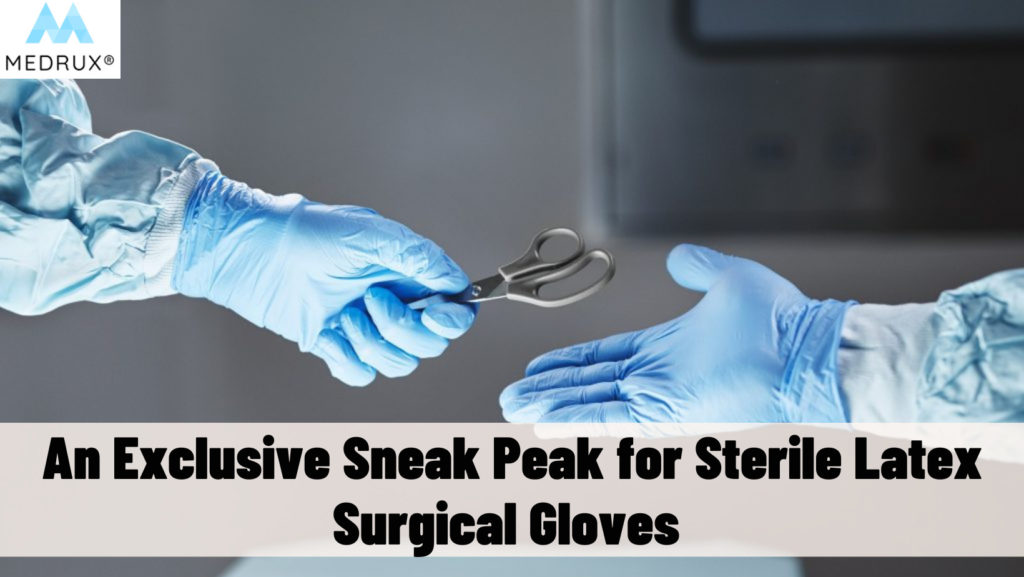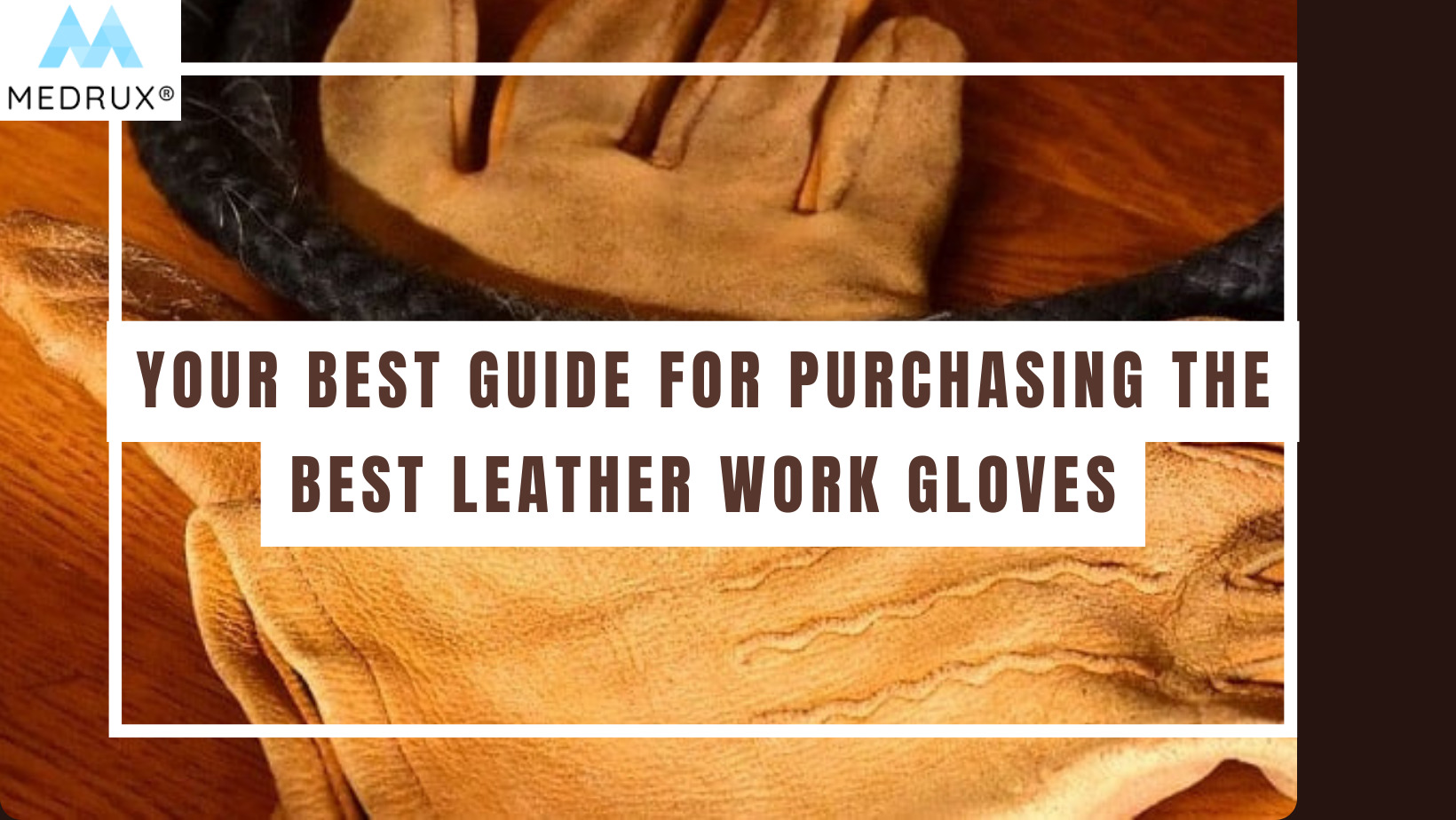Gloves come in different materials, sizes, shapes, and colors.
You can say that there is a glove for every task and every purpose you may think of. And one of these gloves we are going to discuss here specifically is sterile surgical latex gloves.
Are you a healthcare professional?
Are you looking for the perfect surgical gloves?
Here we will answer all your questions: What are Sterile Latex Surgical Gloves? What is the unique thing about them?
Moreover, everything you need to know about this specific type of glove and many other sterile surgical glove alternatives. But first things first,
What are latex gloves?
Latex gloves are the first disposable and most commonly used in different fields in history.
Latex is a natural polymer in the rubber tree sap; these trees grow primarily in India, Indonesia, Malaysia, Thailand, and Vietnam.
Also, latex is a milky white liquid that has healing functions for the tree itself by coagulation in any cut or damage to the tree’s trunk to block harmful bacteria and insects from going inside the tree.
Moreover, the latex harvesting process goes way back to ancient civilizations; back then, people used latex as a form of glue.
However, latex exists not only in the rubber tree but also in the cells of many rubber-producing plants.
Also, latex gloves come as powdered and powder-free options.
-
Sterile latex surgical gloves- powdered
Powdered latex gloves contain cornstarch, making them easier to slip on and take off.
This prevents gloves from sticking to your hands which can happen especially when your hands are sweating. Also, powdered gloves offer better agility and comfort.
-
Sterile latex surgical gloves- Powder-free
These types of gloves offer several benefits.
For example, these do not leave messy powder residue on the hands and the working area; powders should never get into the exposed human tissues because they slow down the healing process.
And that takes us to the next point.
FDA ban on powdered gloves
On December 19, 2016, the FDA published a final rule banning powdered surgeon’s gloves, powder patient examination gloves, and absorbable powder for lubrication on surgical gloves based on the substantial risk of illness or injury to individuals exposed to powdered gloves.
Apart from the delayed wound healing caused by the powder, the risk may also include severe airway inflammation and hypersensitivity reactions, triggering an immune response; the exposed tissues may also form granulomas or scar tissues around powder particles.
What are surgical gloves?
Surgical gloves are a type of medical-grade gloves.
Healthcare professionals usually use these gloves in operation rooms while performing procedures. It is a must that every healthcare professional inside the operating room wears them.
Moreover, surgical gloves are usually the highest strength and quality. And they are also PPE. Also, these gloves are sterile and come in separate packaging per pair.
But what is PPE?
PPE stands for personal protective equipment.
They are protective clothes, helmets, goggles, gloves, and more.
PPE’s primary function is protection from different hazards ranging from physical, electrical, and chemical threats to airborne particles and microorganisms.
Of course, medical-grade gloves are a part of personal protective equipment.
There are four levels of PPE: level A PPE, level B, C, and D. Ranging from most protective (A) to least protective (D).
A glance at the manufacturing of sterile latex surgical gloves
After making latex gloves from rubber, to make sterile surgical gloves, latex gloves go through the sterilization process.
The gloves go into special washing machines with di-ionized, UV-treated water filtered to 0.2 microns.
After that, the gloves go into clean rooms.
Then, gloves go through drying with high-quality HEPA-filtered air before packaging.
The difference between latex examination and latex surgical gloves:
Surgical gloves require a finer quality to ensure high sensitivity and accuracy for the health care provider due to the sensitivity of the surgical procedure.
-
Examination gloves
They are fit for minimal risk, general tasks, and non-invasive examination processes.
They come in many materials, like latex, vinyl, and nitrile. Also, they are available as powdered and powder-free types.
Moreover, healthcare providers should use these gloves in tasks with minimal contact with body fluids.
-
Surgical gloves
Surgical gloves follow more strict standards for manufacture and more heavy regulations.
And they are highly effective and protective in high-risk situations, like being in contact with blood and bodily fluids that may carry infectious blood-transmitted diseases and microorganisms.
Also, these gloves are mostly powder free because powder can lead to complications if it gets into open wounds during surgical procedures.
Moreover, surgical gloves offer a more accurate size range and provide higher strength, tactile sensitivity, and accuracy for the health care provider.
Before using latex sterile surgical gloves, you should:
Wash your hands thoroughly before wearing your gloves.
Also, ensure your gloves fit you properly, as this is extremely important, especially during surgical procedures, as they require maximum precision and control.
Moreover, make sure neither you nor your patient is allergic to latex before deciding which type of sterile surgical gloves to use.
Even more, be aware that if you misuse sharp objects, you might puncture your gloves even if they are puncture resistant to a certain extent.
And also, make sure you regularly check your gloves for any tears or punctures; if you find any, change them immediately.
Also, after removing your gloves, wash your hands with soap and water or with alcohol hand rub.
Last but not least, never reuse medical gloves, wash or disinfect them and never share them with anyone to be reused under any circumstances.
And to put it into steps to make it easier to understand,
Ten easy steps to put on your sterile surgical latex gloves:
- Choose the right surgical latex glove size for you. It should fit you comfortably to offer the best hand movement.
- Prepare your clean, sterile work area before wearing your sterile gloves.
- Wash your hands thoroughly, following proper hand hygiene protocol with soap and water.
- Open your individually packaged sterile surgical latex gloves.
- Put on the first glove, starting with your dominant hand, hold the glove’s cuff, and slip your hand into your glove while only touching the inner part of the glove.
- Using your gloved hand, slip your hand into the folded cuff of the other glove and lift it.
- Pull the glove over your fingers, and then pull the glove over your hand with your thumb up.
- Make sure your gloves are both well-adjusted to your hands.
- Please do not touch anything with your gloved hands; it’s best to keep your hands in front of you to avoid accidentally touching anything that is not sterile.
- Remove your gloves after using them, and follow the same hand-washing technique.
For how long can you wear sterile surgical latex gloves?
If you do not touch anything that is not sterile with your gloves, and if nothing punctured or tore your gloves.
If you use these gloves in the intended medical setting, you have roughly 4 to 6 hours for one pair of gloves.
Of course, this can be either longer or shorter depending on various aspects, like if you use these gloves for different purposes or if your gloves become contaminated with blood and bodily fluids.
You should always change gloves when you:
- Begin a new task (like examining a new patient).
- Notice any puncture or tear in your gloves.
- Handle or come in contact with any biohazard.
- Handle harsh chemicals.
What is double gloving?
Double gloving is a technique many healthcare professionals use to provide higher protection and safety.
The name explains that healthcare professionals use two sets of surgical gloves rather than just one. They use this technique because the naked eye may not detect many surgical gloves’ perforations, which is dangerous.
After all, microorganisms can easily pass through these perforations even if you cannot see these cuts on your gloves.
And that is why this method significantly lowers the risk of infection for all parties.
And to make detecting cuts and tears even easier, healthcare professionals wear different colored gloves over each other.
Why use sterile surgical latex gloves?
Latex gloves are disposable, have a wide range of uses, have multiple colors for different services, offer superior protection against microorganisms and bodily fluids transmission, and have the most stretchy feel and precise movements for surgeons.
They are also the most cost-effective due to the lower cost of natural latex.
Also, they are comfortable to wear for long hours, allowing unrestricted motion.
And, of course, since they are from a completely natural source, latex gloves are echo-friendly and can decompose naturally after disposal.
However, due to the rising concern of latex allergy, not many healthcare professionals nowadays prefer using surgical latex gloves.
Because even if the health care provider themselves do not have a latex allergy, there is always the possibility that one of their patients might have it, and they may not even be aware that they do.
To make it easier for you to decide on your sterile surgical glove of choice,
Here is your guide on how to choose your surgical gloves:
-
Glove material
Each material has advantages and disadvantages for each unique task, whether it is latex, nitrile, or neoprene.
We will mention them later in this article in detail to help you decide which is more suitable for your unique use.
-
Glove size
Gloves that are too large wrinkle while you use them; also, they can slip off easily while you are doing your task.
However, too small gloves will restrict your hand movements, rendering them inaccurate and might even cause pain in the wrists.
That’s why you must use gloves that fit you perfectly for precise hand movements and more comfortable use.
-
Glove strength
Gloves must be strong enough to protect you against microorganisms and surgical blade tears and punctures and maintain flexibility and ease of movement while maintaining the balance between thickness, puncture resistance, and agility.
-
Glove-task compatibility
For example, you can not use powdered gloves for surgical purposes.
You can not also use latex gloves for allergic individuals. Also, flexibility and puncture resistance are the essential qualities of surgical gloves.
-
Standard specifications
For surgical gloves, gloves material should be any rubber polymer compound, and the inside and outside surfaces of the gloves should be powder-free.
Also, gloves should have extended cuffs above the wrist, ideally reaching up to the mid-forearm.
Moreover, gloves should be able to withstand repeated autoclave cycles.
And also, thicknesses as per ISO 10282:2014, tensile strength min 18MPa, and elongation at break min 700%.
After viewing these criteria and studying them well, you may find that latex surgical gloves are a perfect choice.
If not, if you are your patient has a latex allergy, then we will discuss other popular sterile surgical gloves options.
Alternative latex sterile surgical glove options:
-
Vinyl gloves
Powder-free, latex-free, affordable disposable glove option for people with latex allergy.
Manufacturers create vinyl gloves from a synthetic material called PVC; the raw material is usually rigid, so manufacturers add plasticizers called phthalate to make it more flexible and pliable enough to transform into gloves.
However, these gloves are less resilient and more vulnerable to tear and puncture than other glove types. That’s why people usually use vinyl gloves for light-duty tasks.
Moreover, vinyl gloves are more permeable to microorganisms and have low chemical resistance.
All these reasons mentioned above are why we recommend using vinyl gloves only as examination gloves and not surgical gloves.
Here is our comprehensive guide to learning more about vinyl and latex gloves.
-
Nitrile gloves
Synthetic glove option made from butadiene and acrylonitrile, a perfect choice for people who suffer from latex allergy. Nitrile gloves have many uses, from medical and food industries to tattooing gloves.
Also, nitrile material is resistant to temperature changes and many chemicals. Also, it is durable, very flexible, and shows a more significant puncture resistance than latex and vinyl.
Moreover, nitrile gloves have a relatively long shelf life, making them more efficient to store for hospitals and other healthcare facilities.
Even more, nitrile gloves come in many different colors; many surgeons use this significant quality in double gloving, as we mentioned earlier.
They wear two pairs of gloves with different colors, so it can be easy to spot tears in the outer glove more efficiently to avoid cross-contamination.
Also, some medical facilities use blue gloves for surgeries and orange gloves for less invasive tasks, like light examination.
And one of the significant advantages of nitrile gloves is that you can recycle them if they are not contaminated with biohazardous materials.
However, the only major disadvantage of nitrile gloves is that nitrile chemical dissolves when used with acetone.
Learn more about the difference between nitrile gloves and neoprene gloves here.
-
Neoprene gloves
Synthetic, powder-free glove material, the first manufactured synthetic rubber from the polymerization of chloroprene, mainly carbon, hydrogen, and chlorine polymer.
Most sterile surgical neoprene gloves have nitrile coating on them.
Moreover, they have excellent resistance against microorganisms, alcohol, and many other chemicals. Also, it is resistant to temperature changes, sunlight oxidation, radiation, and UV. And also it is perfect for handling flames.
However, compared to latex, neoprene gloves show less elasticity and comfort to the user and are also relatively expensive. That’s why neoprene surgical gloves are not usually the first option.
-
Polyisoprene gloves
Similar in structure to rubber latex, polyisoprene is a synthetic glove material.
It shows elasticity and flexibility, is comfortable to wear and offers strength and puncture resistance.
Also, this type of glove is the best synthetic option for comfort, flexibility, and agility.
Many people feel like these gloves are the best option for latex allergy because they feel very similar to latex, minus the massive threat of an allergic reaction.
In general, many healthcare professionals believe that polyisoprene gloves are the best sterile surgical glove option.
Conclusion
Sterile surgical latex gloves have many attractive qualities for the health care provider and the environment.
Also, choosing the suitable surgical gloves type is an essential issue with many factors to consider, starting from strength and flexibility to protection against microorganisms and bodily fluids leakage through the gloves, all the way to avoiding unnecessary incidents like unexpected allergies that may affect the surgeon and the patient.
And in this day and age, technology offers us many options tailored for every unique need and use. We hope we were able to answer all your questions.
As always, stay safe and ask us any question you want in the comments; we may be able to help you.
Hajar Nagdy is a microbiologist and a lecturer. Nagdy holds a Bachelor’s degree in the fields of microbiology and environmental sciences, and she is now a M.Sc. candidate in microbiology. In her free time, she can be found listening to classical music, reading interesting scientific articles, running a charity, or traveling across Europe.








